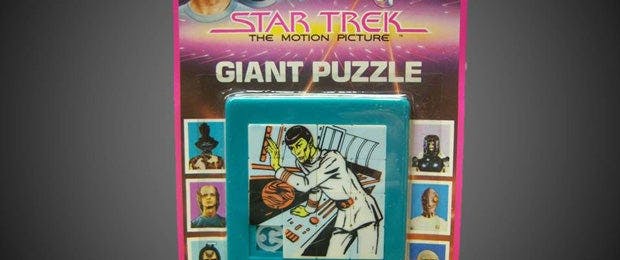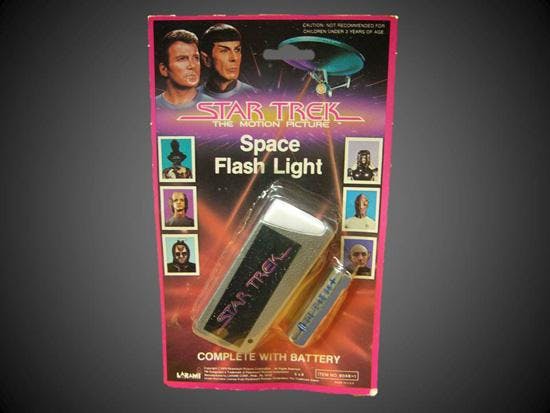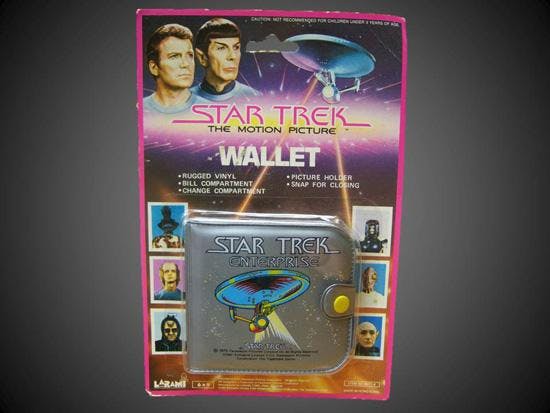Published Oct 9, 2014
Who Didn't Love Larami's Star Trek: TMP Tie-in Products?
Who Didn't Love Larami's Star Trek: TMP Tie-in Products?

There has never been a Star Trek film that resulted in as much merchandise when it premiered as Star Trek: The Motion Picture. When the film opened 35 years ago, on December 7, 1979, the anticipation among fans was palpable and mainstream attention intense. Newspaper coverage was consistent beginning with the March 1978 press conference, then the largest in Paramount Studios history, announcing the film itself. Each aspect of production – from the casting of Persis Khambatta to the creation of the special effects – received media spotlights.
Commiserate with such a widespread enthusiasm for the film, an amazing variety of collectibles and memorabilia were available for fans who wished to continue the “Human Adventure” that the film promised was just beginning: the first ever film themed McDonald’s Happy Meals, free trading cards available inside Rainbo Bread packages, toys and playsets from the MEGO Corporation, soundtrack LPs, comic books, making of books, TMP-themed First-Aid kits, arts and craft projects, ad infinitum.

Some of our favorite ST:TMP items were released by the Larami Corporation. Known for their slogan, “Toys For All Seasons,” Larami specialized in what the Philadelphia-based company called “rack, shelf, and counter impulse toys.” Larami toys could be found in drug stores and grocery aisles, strategically located for younger eyes to see. Priced usually between .39 and .99 cents, the toys were affordable for kids with allowance budgets and presented little in the way of sticker shock. With licenses for properties such as Buck Rogers in the 25th Century, C.H.i.P.s., Marvel Comics, and Battlestar Galactica, Larami kept costs down by reusing molds and designs across various characters and lines.

Their Star Trek: The Motion Picture line included a space flashlight, pair of sunglasses, puzzle, photo blaster toy, space viewer, I.D. set, wallet, transfer putty and signal gun. Not only were Larami toys inexpensive, many of the Star Trek: The Motion Picture items were also gender and age neutral, creating even more appeal. This was a wise move because the diversity that Star Trek shows in its onscreen adventures is also true of the real people that make up its fan base. Additionally, items like the flashlight, sunglasses, and wallets were practical items that could be used in addition to being played with or displayed. Indeed, during the 1970s, the Spock slider puzzle was the touch-screen tablet game of its era.

The packaging deserves a special mention. While the back of the packaging for most ST:TMP Larami items were blank (read: cost effective), the front featured a cool color scheme and images of Admiral James Kirk and Spock. Also featured on the packaging were some of the aliens from the U.S.S. Enterprise crew assembly and Starfleet headquarters scenes. The Betelgeusian, Rhaandarite, Megarites, Rigellians, Saurian and Vulcan characters were prominent also in the trading cards and MEGO toy lines because of their innovate designs and kid-friendly appeal. The consistency of the packaging in the Larami line helped the toys be easily identifiable and add to their shelf appeal.

Larami Corporation was eventually purchased by Hasbro Inc., and the name has faded into history. However, Larami’s Star Trek: The Motion Picture items are still around in collector circles and on the secondary market. They instantly transport us back to a time when fun and futuristic toys could be found at local grocery stores. Who needs warp drive to pick up enough speed for time travel when the Larami’s impulse purchase toys accomplish the same thing?
_________
Maria Jose and John Tenuto are both sociology professors at the College of Lake County in Grayslake, Illinois, specializing in popular culture and subculture studies. The Tenutos have conducted extensive research on the history of Star Trek, and have presented at venues such as Creation Conventions and the St. Louis Science Center. They have written for the official Star Trek Magazine and their extensive collection of Star Trek items has been featured in SFX Magazine. Their theory about the “20-Year Nostalgia Cycle” and research on Star Trek fans has been featured on WGN News, BBC Radio, and in the documentary The Force Among Us. They recently researched all known paperwork from the making of the classic episode "Space Seed" and are excited to be sharing some previously unreported information about Khan's first adventure with fellow fans. Contact the Tenutos at jtenuto@clcillinois.edu or mjtenuto@clcillinois.edu.

